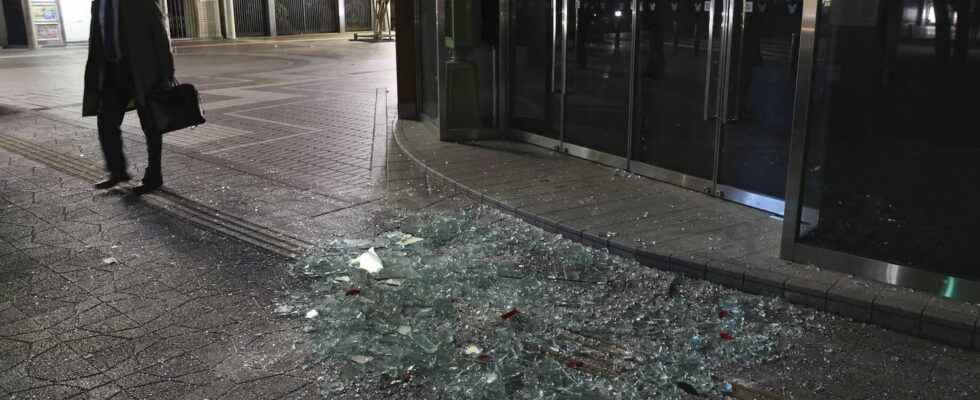TSUNAMI ALERT. While a 7.3 magnitude earthquake in Japan was recorded not far from the Fukushima nuclear power plant, a tsunami warning was issued on Wednesday March 16. Finally, the alert was lifted this Thursday, March 17, but the earthquake left at least one dead and dozens injured.
[Mis à jour le 17 mars 2022 à 14h03] the Japan came close to the worst. An earthquake of magnitude 7.3 on the Richter scale of mighty was recorded on Wednesday March 16 about 63 kilometers deep off the island. Triggered at 11:36 p.m. local time (according to the United States Geological Survey (USGS), the phenomenon occurred 57 kilometers from Namie. A tsunami warning was issued on the northeast coast (for the Fukushima and Miyagi prefectures) due to its proximity to the epicenter of the tremor. It was lifted on Thursday, March 17.
At least one person died in the coastal town of Soma and dozens more were injured in the quake, Japan’s Kyodo news agency said, with authorities saying they received numerous emergency calls. Two million Japanese homes were without electricity. The tremor was so violent that it was felt in eastern Japan, even impacting Tokyoites, according to the Japan Meteorological Agency (JMA). For the moment, no damage is to be deplored in the Fukushima nuclear power plant. But the fear of seeing history repeat itself is strong, this plant having been devastated by a Tsunami in 2011.
Japan, a regular earthquake
Unfortunately, Japan is a country accustomed to tsunamis and tremors of all kinds since thousands of telluric tremors of varying intensity are felt there each year. While most cause little or no damage to human constructions, some underwater tremors have been powerful enough to cause tidal waves called earthquakes. Even today, with 100,000 earthquakes per year, Japan is the country of origin of 1/5 of the earthquakes of a magnitude equal to or greater than 6 recorded in the world. The magnitude of recent earthquakes is around 7 to 8 (on the Richter scale) and hundreds of deaths have been recorded, like the earthquake of Kobewith a magnitude of 7.2 which caused nearly 6,500 deaths and that of Tohoku off Sendai, with a magnitude of 9.0 and which left more than 18,000 dead and missing. As Japan is an archipelago, these tremors can be accompanied by destructive tsunamis and tidal waves. Japan is a seismic zone because it is located at the meeting point between 4 major tectonic plates: the Okhotsk plate to the north, the Pacific plate to the east, the Philippine plate to the south and the Eurasian plate to the west. When these plates move, they produce what is called plate tectonics and earthquakes occur.
What happened in Fukushima in 2011?
The Fukushima “disaster” of March 11, 2011 is one of the biggest industrial accidents in history and the 2th biggest nuclear power plant disaster. Appearing at the same level of gravity as the Chernobyl disaster of 1988, it was caused by an earthquake of magnitude 9, followed by a tsunami which devastated the coasts of Japan for 600 km. 22,500 people were victims, whether dead or missing, according to the Japanese Ministry of Reconstruction. In addition, 160,000 people had been evacuated from the 20 km exclusion zone surrounding the Fukushima nuclear power plant, deserted because of the very high level of radioactivity that remains there. Experts estimate that it will take 40 years for the plant to be completely dismantled. This accident having combined the effects of a nuclear accident and an earthquake, it is remembered as the catastrophe to be avoided, or at least to be anticipated at all costs. This is why the tsunami alert sounded near Fukushima this March 2022 is so worrying.
Seismic risk prevention in Japan
Aware of these many risks, Japan has developed effective earthquake-resistant construction techniques, reinforced several times until they became mandatory throughout the territory after the Fukui earthquake of 1948 (magnitude 7.1, it killed nearly 3770 people). The law still in force today was introduced in 1981, after the Miyagi earthquake of 1978 (magnitude 7.7 and 28 deaths). It is based on three complementary and broad enough seismic construction methods to protect all types of construction and urban project. In addition, guides are made available to the population, and exercises are carried out from an early age to prepare the Japanese to protect themselves in case the worst happens.
